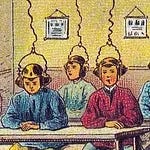One of the most direct ways to experience a scenario or an alternative future is via the creation of artifacts that participants can see, touch, or otherwise interact with1. One of the purposes of creating these artifacts is, to borrow a phrase, to “make the strange familiar, and the familiar strange”. That is, we should be able to examine futures very different from the present and see how they make sense as an outgrowth of things we're familiar with, and we should understand how present institutions and conventions aren't the only or even the natural way of doing things, but more of a contingent historical arrangement.
Even though it's not about the future, I wanted to share the best set of artifacts from an imagined reality I've ever seen: Mystery Flesh Pit National Park. The premise is that a city-sized eldritch subterranean organism is found in Texas in the 1970s and is subsequently developed into a popular tourist attraction, closing in 2007 when all the visitors are trapped inside and digested; basic Lovecraftian horror meets late-20th-century road trip Americana stuff. Regardless of how that intersection strikes you, I think you’ll appreciate the dedication to craft from creator Trevor Roberts.
Exhibit A: this diagram of the Lower Visitor Center.
There are two things I find praiseworthy here and that translate directly to Futures work: first, the amount of incasting done to really work out what the logic of the setting would suggest; second, the attention to detail in “making the strange familiar” by so faithfully mimicking the look of collateral from the National Park Service.
Exhibit B: this T-shirt available from the gift shop:
Here, the attention to detail is complemented by the tactile nature of the product - it’s a real shirt! T-shirts, caps, stickers, patches, etc are pretty cheap and quick to have printed these days (especially if you don’t feel the need to add blood), so if you have the time and budget as part of your engagement, this kind of thing might both enhance the experience and make it more memorable for participants2.
Because these artifacts speak so clearly to the role of Futures and Foresight in stretching people’s imaginations to imagine new possibilities, they reveal the power of solid design skills for futurists. There are other ways to get similar effects (great writing being one example), but probably nothing is as visceral.
The second half of the week 13 edition talks about how these artifacts might fit into a broader experiential exercise.
There isn’t really a cap on how much “future” you can design with infinite money, as the Museum of the Future makes clear.





